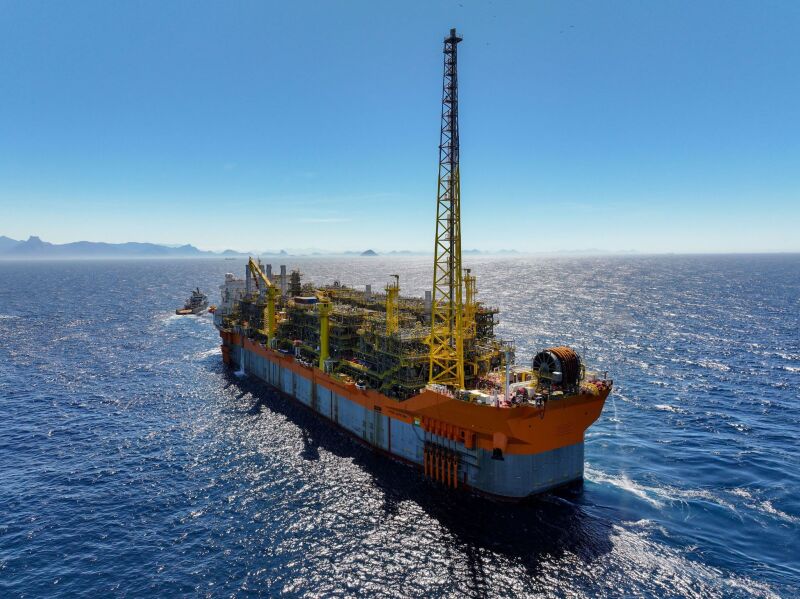With platform hookups now completed, Petrobras said it is poised to transport first gas via the new Rota 3 pipeline in early October from the Santos Basin pre-salt fields to Brazil’s largest natural gas processing unit (UPGN) which was just commissioned at the GasLub hub in Itaboraí, Rio de Janeiro.
Gas destined to enter the system is largely associated gas of which 60% is currently reinjected during oil production. It accounts for nearly 76% of Brazil’s 13.4 Tcf in proven natural gas reserves, according to the US Energy Information Administration’s 2023 Brazil country brief.
In late August, Brazil’s President Luiz Inácio Lula da Silva signed a decree requiring Brazil’s oil regulator ANP (Agência Nacional do Petróleo, Gás Natural e Biocombustíveis) to limit gas reinjection at new wells to divert more gas to the domestic market. Once Rota 3 goes onstream, adding its 18 million m3/D capacity to the already functioning Rota 1 and Rota 2 pipelines systems, the Santos Basin’s gas grid will grow to 44 million m3/D of gas capacity thus supporting this goal, according to data and analytics firm BNamericas which reports on the Latin American market.

Moreover, Brazil has mapped at least 11 prospective gas pipeline/processing unit projects, seven based on pre-salt volumes and four based on post-salt volumes aimed at potentially doubling Rota’s current network after it reaches capacity in 2025, BNamericas said.
Rising Project Costs Could Temper Interest in Brazil’s Offshore
Rystad Energy’s Managing Director for Latin America, W. Schreiner Parker, however, notes that while the government’s edict may help fuel Brazil’s growing industrial sector, it could also cool investor interest in future oil and gas projects in Brazil if project costs escalate.
“For companies like Equinor, Shell, and Petroleo Brasileiro SA (Petrobras), the new rules could impact the economics of their offshore projects,” Parker wrote in a recent Rystad analysis comparing Brazil’s energy policy to that of neighboring Argentina whose President Javier Milei —in contrast to Brazil’s Lula—seeks growth through limited government.
“If the policy leads to higher gas transport costs or mandates more gas to be diverted from reinjection, it could affect project feasibility and profitability,” Parker wrote. “Equinor and Shell are evaluating how the decree might affect their multibillion-dollar offshore investments in Brazil.”
He added, “It’s worth noting that the rule will only apply to new wells and won’t affect existing contracts.”
Meanwhile, Magda Chambriard, CEO of state-controlled Petrobras, told reporters at a news conference in August that the company will reduce gas reinjection where possible but not all its oil production platforms are designed to handle gas shipments.
Chambriard said the company envisions using platforms planned for the giant Búzios offshore field to create a gas hub.
Petrobras is also eyeing imports including shale gas deals in Argentina as part of a bigger plan that stretches across the Atlantic Ocean to Africa’s Atlantic coast. Bloomberg recently cited confidential sources that Petrobras wants to acquire a stake in Argentina’s Tecpetrol SA, a unit of billionaire Paolo Rocca’s Techint Group.
In Africa, Petrobras is studying some 10 options to partner with oil majors including ExxonMobil and Shell, the Brazilian major’s E&P head Sylvia dos Anjos told Bloomberg.
That includes a possible operatorship with a 40% farm-in to Galp Energia's Mopane oil and gas field in Namibia and recently acquired minority stakes in three blocks from Shell in Sao Tome and Principe, two islands offshore Central Africa that exhibit a geology like Guyana.
Argentina Preauthorizes Gas Exports to Brazil
In August, Argentina preauthorized Tecpetrol and TotalEnergies to export gas to Brazil, according to officials in the province of Neuquen, which holds the largest share of Argentine shale reserves, according to Bloomberg.
Petrobras divested its Argentina assets some years ago but kept a 34% stake in the Rio Neuquen shale gas field, a venture with YPF and Pampa. Argentina President Milei’s pipeline buildouts and deregulation are said to be driving drilling investment as production in the Neuquen Basin has reached seasonal highs exceeding 1 million BOED.
Rystad’s Parker noted that Argentina’s new Basis Law includes incentives for large investments aimed at constructing pipelines and export terminals related to the Vaca Muerta shale play which is regarded as being in the same league as the Permian Basin in the US.
Projects exceeding $200 million are guaranteed 30 years of legal and regulatory stability, assuming that 40% of the investment is made within the first 2 years, Parker said. Projects over $1 billion are eligible for significant tax breaks including export and import tax exemptions.
In August, Petrobras announced it is evaluating the feasibility of interconnecting the electrical systems of the four FPSOs in Mero field in the Santos Basin (the Guanabara and Sepetiba which already operate in the pre-salt, and the Marechal Duque de Caxias and Alexandre de Gusmão which are set to come on line by 2025, according to BNamericas.
With the four platforms, the Mero field will have the capacity to produce up to 720,000 B/D of oil and process 48 million m3/D of natural gas, BNamericas noted.


